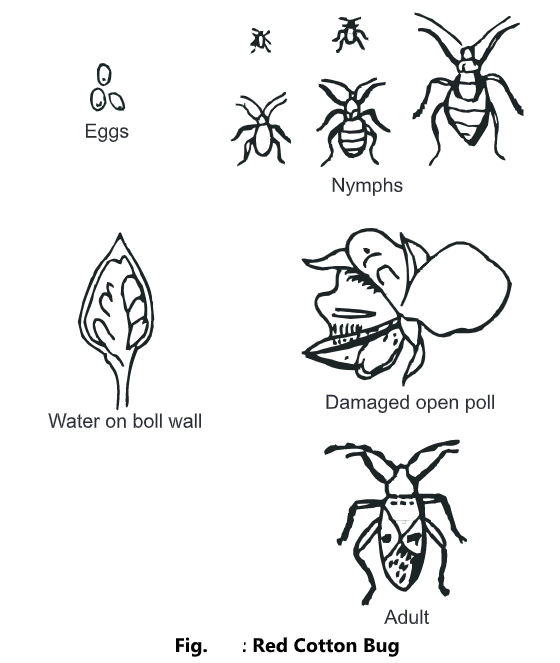Red Cotton Bug
Class – Insecta
Order – Hemiptera
Family – Pyrrhocoridae
Genus – Dysdercus
Species – cingulatus = koenigii (Fab)
The red cotton bug is widespread; it is a minor pest in northern India’s cotton-growing regions, particularly Punjab and Uttar Pradesh. This pest is found throughout Maharashtra, but it is of minor importance. It is commonly referred to as a “cotton stainer.”
Host Plants:
Cotton, ambadi, hollyhock, bhendi and several other malvaceous plants.

Identification Marks:
- The adult bug measures about 12-15 mm in length. The females are longer (15 mm) than the males (12 mm). It is blood red in colour except for eyes, scutellum, anal, antennae which are black coloured.
- Besides, each of the membranous forewings has a black spot. On the ventral side of the abdomen, there are a series of white transverse bands.
- Mouthparts are adapted for piercing and sucking. They form a straight beak or rostrum. The nymphs are wingless and smaller than adults.
Life Cycle:
- During the spring, the mature female lays 70-80 eggs in clusters under the moist soil surface, fallen leaves, and crevices. The eggs are spherical, yellowish-white about 1.2 mm in length.
- After 7 days of incubation and moist weather, eggs hatch into active 1 mm long red nymphs that resemble adults except for size and the lack of wings. The nymphs feed gregariously on the cotton bolls.
- The nymphs undergo 5 moults within 49-89 days to reach the adult stage.
- In winter, the life of the adult is about three months but in summer it is varied. From August to November, the pest breeds on cotton; from December to the middle of March, it seeks refuge under leaves or debris; and from April to July, it feeds on bhendi.
- The life cycle of the bug is completed within six to eight weeks.
Nature of Damage:
Both nymphs and adults suck the plant’s vitality by sucking the cell sap from the leaves and tender shoots. Bolls open badly and the lint is of poor quality if the attack is severe. Furthermore, they feed on the seeds, lowering their oil content and germination percentage; such seeds are unfit for sowing. The excreta of bugs or their body juice stain the lint as it is crushed in the ginning factories.
Control Measures:
1. Cotton field should be ploughed to expose eggs to sunlight.
2. Insects should be handpicked and killed in keratinised water.
3. The crops of bhendi should be sown as a trap crop and pests collected there, should be destroyed.
4. Moistened cotton seeds should be hunged up at different places in the field where bugs congregate, they may get killed in the kerosene mix water.
5. Spraying of Malathion 0.05% is effective to control the pest.
6. Spraying of 1-litre endosulfan 35% EC, 0.25 litre phosphamidon= 100% EC or 1-litre Fenitrothion 100% EC per hectare is very effective or reduces pest population.